When I was a youngster I had a dream. That dream was to play baseball. I knew at a very early age that major league baseball would be an impossibility for me. Still, I had a dream to play at a level below the big leagues. I think that yearning came from watching the Liverpool Larrupers play in the Halifax and District League in the early fifties. Liverpool was about an hour’s drive from my hometown of Lunenburg, Nova Scotia. I absolutely loved going to that little park with my parents. During those games I did see some future major league players in action: Zeke Bella later played with the Kansas City Royals, Tom Gastall with Baltimore and Moe Drabowsky who pitched so well against the Dodgers in the 1966 World Series. Jack Kubiszyn, a shortstop, was my absolute favorite player on the Larrupers in 1955. He played briefly for the Cleveland Indians.
What I remember most about those games were the sights and the sounds. The fans were very involved in the games cheering the hometown heroes, jeering the opponents and chastising the umpires. Most of all I remember the sounds: the ball hitting a glove, the crack of the bat (my favorite), the sound of a player sliding, the constant infield chatter encouraging the pitchers – maybe Don Swanson (LHP) or Ron Jirsa (RHP) – a low minor league version of Sandy Koufax and Don Drysdale in 1954.
My dream of minor league baseball also soon died as I realized that if I had difficulty hitting the ball as an early teen, my hitting futility would only grow as I tried to advance to higher levels. Yet, my fascination with minor league baseball never waned, but in fact grew stronger and continues to grow even to this day as thousands of young players follow their dream. They get to do what most of us never could. That is, play the greatest game in the world and get paid to do so. Out of curiosity, I recently completed some research on the life of minor league baseball players, the life of which I had dreamed.
Minor League Baseball is big business in the United States and Canada. More than 41.2 million fans attended Minor League Baseball in 2012. Few would know that Minor League Baseball draws more fans than the NBA, NFL and the NHL. While fan support in the minor leagues continues to grow, each year there are thousands of young men actively pursuing their dream. However, very few get to live out their full dream. Approximately one in 200, or about 0.5 percent of high school senior boys playing interscholastic baseball will eventually be drafted by a Major League Baseball team. After that the odds don’t get much better. Of the thousands of high school, college, and unaffiliated players, probably about 3 percent of those drafted or signed ever make an appearance at the Major League Baseball level. That means that out of 10,000 high school seniors, about 15 may make it to big leagues. Those players who do become major league players often take five, six or more years to graduate to their parent teams.
The Major League Baseball minimum salary under the new collective agreement in 2012 was $480,000, up from $300,000 in 2003. It will increase to $500,000 in 2014. One expects that the same agreement would increase the minimum salary for minor league players by a commensurate rate. A quick check of the salary scale for minor league players reveals some big surprises. The rate of pay has not increased very substantially for quite a few years and that rate of pay at the minor league level is based only on the months of play during the season. Those rates are before taxes and clubhouse dues. Yes, clubhouse dues that pays the salary of clubhouse managers.
Minor League Baseball Salary Scale
For minor league players their best opportunity at financial security comes with signing bonuses which are often quite large for high draft picks. Those that make it to the 40 man rosters on major league baseball teams can receive a reasonable salary, but not many 40 man roster spots are available for roughly 5500 minor league players. The vast majority do not have big signing bonuses and do not make it onto 40 man rosters. Minor league free agents may also earn a livable wage by negotiating their contracts. But, it takes seven years of minor league play to become a free agent. The majority of minor league players, especially at the lower levels, live at a subsistent level having received a small signing bonus and with an unbelievably small income. Many do not make it to free agency as they are released, have their careers derailed by injury or simply have to forgo their dream knowing it will never be realized.
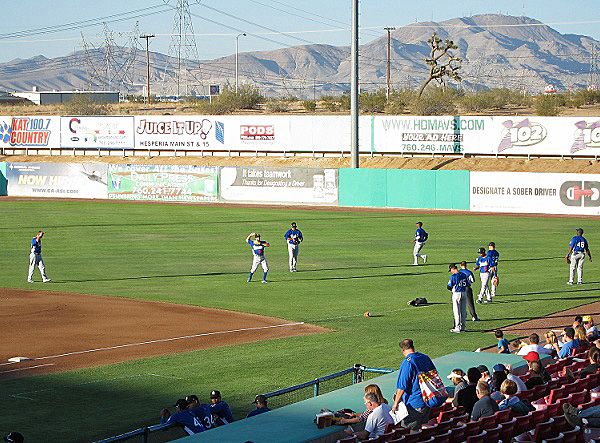
When you add up the seemingly endless hours of hard work, a minor leaguer makes around $7 an hour.
(Photo credit – Ron Cervenka)
To put things in a perspective that we all understand, it is necessary to look at the daily schedule of a minor league player. From May to August, where games are scheduled nearly every day, players arrive around 3 pm for a 7:15 pm game. During the time before games young players stretch, work on fundamentals, taking batting practice, run, throw bullpen sessions, and spend time in the trainer’s room. The typical game takes about three hours to complete. Following the game players often need further work in the trainer’s room, lift weights, shower and generally get ready to go back to their residence as tired young men. Players are at work for a minimum of eight hours, often longer, for about twenty eight days a month. In some states, a minor league player is being paid at a level below the minimum wage. Those hours do not include long and late trips on a bus traveling from city to city or town to town. For a player making the Double-A minimum of $1,700 a month, he’ll earn around $7.00 an hour while on the job.
Minor league players get a daily food allowance of $20-25, depending on the source you read. Hard working young men are trying to gain proper nourishment on $25 a day. How well can most people do that, much less minor league players giving it all they can to try to earn a starting spot on the team at a given level or striving to advance to a higher level? Phil Coke finally made his way to major league baseball after six years, at times seriously considering quitting baseball. His story is one played out in the lives of many minor league players. In order to continue his pursuit of a baseball career, he took on other jobs such as janitorial work and working as a chimney repairman.
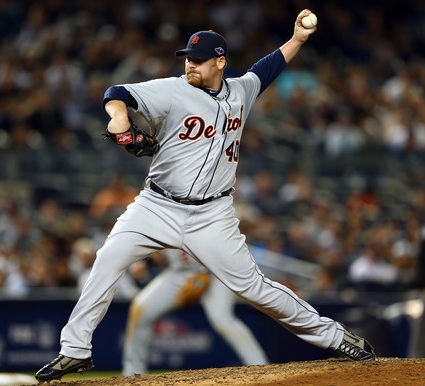
Tigers left-hander Phil Coke seriously considered quitting baseball during his six years in the minors before finally making it to the Big leagues. (Photo courtesy of zimbio.com)
Coke, in an interview with Jonah Keri of GRANTLAND spoke of being destitute: “For minor leaguers, being broke also means subsisting just about entirely on fast food, a curious way for teams to develop finely tuned athletes.” For Coke, this created an additional problem as his weight ballooned to 245 pounds. Russell A. Carleton from Baseball Therapy gave a similar account: “Not surprisingly, left with little cash, a need for calorie-dense food, and no infrastructure with which to purchase and/or cook healthy food, baseball players fall back on food that is quick, fatty, and cheap, not to mention available everywhere: fast food.” Carleton does acknowledge that some teams do offer post game meals but the frequency varies from organization to organization and from level to level. However, he concludes: “But especially on the road, players do end up eating a lot of fast food—in a business where prime physical conditioning is something of a job requirement.”
The life of a minor league baseball player revolves around practice, games, meals, sleep and travel. A large portion of their meager income is used for living accommodations which are not provided by the team. For most, a car is out of the question. One wonders how and why so many young men continue to live a life that excludes all the glamour we, as fans, see from the outside. They continue on against all obstacles in a profession that includes the most difficult task in all of sports. That is, hitting a small round ball coming to the plate at 80/90 mph and doing so with a round bat. The pitchers are likewise trying desperately to miss those bats or at the least the fat part of the bat. Those young players who toil for years in the minors simply refuse to give up on their dreams no matter how difficult the path becomes or how slim the chances of getting to the big leagues may be.
Outfielder Collin Cowgill, who made it to the Big leagues with the Arizona Diamondbacks at age 25 after spending five years in the minors, summed it up like this: “(You are) constantly defying the odds, there are only 750 spots. I know for those guys that do (make it), the feeling of accomplishment has got to be pretty amazing. I wouldn’t want to be doing anything else. I’ve been wanting to do this my whole life.” Cowgill was traded from the Diamondbacks to the Mets this off-season.
But perhaps the most tenacious minor leaguer of all time is John Lindsey, who will begin his 18th season of professional baseball this spring with the Detroit Tigers.
In 2010 while with the Dodgers Triple-A affiliate Albuquerque Isotopes, Lindsey was finally rewarded for his years of dedication and hard work when he received a September call-up from the Dodgers. Although the 35-year-old Hattiesburg, Mississippi native only had thirteen plate appearances during his brief major league debut, it is an experience that he will cherish for the rest of his life. But was it enough for him? “I’ve been waiting all my life for this,” Lindsey told the Los Angeles Times about his major league call-up. “It was an awesome feeling.”




 January 29th, 2013 at 6:11 am
January 29th, 2013 at 6:11 am  by Harold Uhlman
by Harold Uhlman 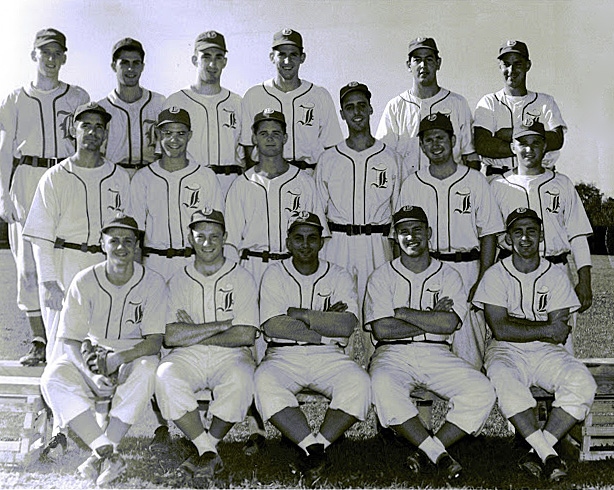
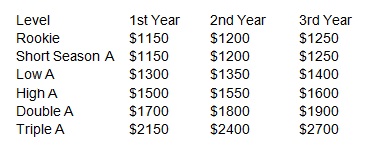
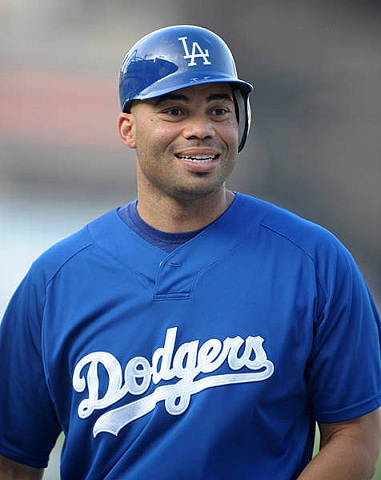
 Posted in
Posted in 

Great story, Harold. John Lindsey played with the Mud Hens last year and ALWAYS had a smile on his face.
John had an outstanding season this past winter in the Mexican League – good enough for him to be given a minor league contract with the Detroit Tigers.
When you look at that salary chart, it makes you realize just how little John has had to live on (and raise his family on) for 17 years.
He is one of those guys who I frequently check up on during the season even though he is no longer in the Dodgers organization because I love the guy. And I am convinced that his smile is permanently chiseled into his face.
Godspeed to you John Lindsey!
The fact John plays in the Mexican League in the winter gives an indication of how lucrative minor league baseball really is even after all those years. You gotta love the John Lindsey’s who play on, as Gary is so apt to say, for the love of the game. John wears a constant smile and in turn puts a smile on the face of those he meets.
WTG John.
In the picture of the Larrupers, in the back row, second on the left, is a young Nova Scotian – Bill Whalen. I taught school with Bill for a few years. He is the one I mentioned a year or so ago that died of ALS.
Bill was a superb athlete and if he had attended college in the US, he may well have made it to a much higher level. He was a fierce competitor.
Ken from isportsweb here. Nice article.
During her high school years, my daughter “ran in the same circles” as that Chatsworth High baseball group that included Mike Moustakas of the Royals. She still keeps in touch with one of that group, a kid in the Reds organization, Josh Raivin. He got some sort of signing bonus so financially for a kid his age, I guess he was better off than most. But still, he has had a somewhat interesting journey from Ohio, to Bakersfield, CA, to Florida last year (AA). She still sees him when he is in town. Not sure where he stands at this point (when I last saw him he said he was throwing 92 and needed to get up to 94 to get to the next level). Funny, I keep saying I’d like to talk to him about life in the minors and do a write-up but I see you beat me to it!! We hope he makes it. Of course, me possibly getting free tickets when the Reds come into town has nothing to do with it!
By the way, based on a review you did of “Trouble With the Curve,” the wife and I viewed it on DVD. We enjoyed it a great deal, especially when we realized reality wasn’t going to have anything to do with it. I know you commented about the relationship aspect of the whole thing but I certainly can say I was nowhere near the Eastwood character when it came down to it. Then again, who knows what my daughter’s point of view would be…….??
Good stuff, Ken, thanks.
I think the thing that struck me most about Trouble with the Curve is that much like the Eastwood character, I never really knew how much my passion for the game (especially for the Dodgers) actually rubbed off on my daughter as a child (she is now 27). Naturally, I always wanted my kids to enjoy the game as much as I do, but that’s one of those things that they have to develop on their own.
It wasn’t until my daughter moved away from home (first to San Diego for college and then to New York where she now lives and works) that I realized just how much of an influence I actually did have on her and her passion for the game – based on the endless flack that she takes from her co-workers (most of whom are Yankees and Mets fans). The fact that she proudly wears her Dodger garb around town probably has something to do with this.
As my good friend Truebluewill can attest, fansince85 holds her own quite well at Mets and Yankee games.
My son’s passion has been far more obvious, as depicted in Bluetopia. He also enjoys attending Quakes games with me at Rancho Cucamonga, but I think that may have more to do with the fact that they have sauerkraut in abundance for their hot dogs (just kidding, Tim). That said, it is going to be extremely difficult for me to maintain my passion for the Quakes now that Busty is gone.
BTW – You have an open invitation to join me for games at Dodger Stadium (Reds or otherwise) if you can handle the LFP (we get a bad rap). Simply give me a couple of days notice.
First I’d like to say that I really appreciate having someone like you Harold on this blog/forum to keep us up to date on the minor leagues. I tried to follow it from time to time in my youth but I never had the time or interest as I have enough trouble keeping up with the parent team, the Dodgers.
I start to take note of a player after he comes up for a few games with Dodgers but it’s too much for me to follow his earlier career but It’s good to get a glimps of them through you, Ron and the others. Again thanks alot, I truly appreciate it.
Glad you enjoy it. I love minor league ball.
There are some blogs listed on TBLA’s sidebar that have much more minor league info than I can offer:
Feelin’ Kinda Blue
True Blue LA
I Bleed Dodger Blue 2 – Evan Chavez lives in Albuquerque and is the eye in the sky with the Isotopes.
Harold, that was a great article!! Since you’ve done so much research on this, I have a question. Somewhere (who knows) I heard that the AAA players who get called up and then moved back now have a completely different salary structure – i.e., if they have ever been in the Bigs, it changes. Do you know if that is true?
I’m not Harold, but your question spurred my curiosity, so I researched it and found this: How is a MLB player’s compensation affected when he gets called up from the minors?
Please note that this was as of two years ago.
The key, as mentioned in the article, is to be on the 40 man roster. Being on that roster is important. Being removed from it is also significant. Ron’s link helps explain it.
The following is from another link with the same info.
Players on the 40-man roster are subject to different pay rules. According to Baseball America, as of 2011, minor league players with one year or more on the 40-man roster, or one day or more of major league play, must be paid a minimum yearly salary $67,300. Minor league players on the 40-man roster who have less than a year’s time on the roster, or who have never been sent up to the majors, must be paid a minimum yearly salary of $33,700.
When they play in the majors (ie. Scott Van Slyke) they get pro-rated MLB pay for the time they are there, if I understand it correctly. Players often spend some time in the majors before being sent back down to the minors the following year. After being sent down, players must be paid a minimum of 60 percent of their previous year’s salary.
That probably doesn’t help much.
Harold, I loved the article! Great perspective… and wouldn’t we all have wished to play for a paycheck, no matter how small?
I’ve long said I find it more fun going to a minor league game then a major league game. I love my Dodgers but the baby Dodgers are my true interest. For those going to ST that’s where you’ll find me the majority of the time !!
I expect it was the Halifax and District baseball League that did it for me.
Here’s something I didn’t know from The Nova Scotia Sports Hall of Fame. Over 40 players from that league made it to the majors.
In the 13 years following World War II, a time when people were feeling exuberant and expressing that exuberance in play, Nova Scotia was home to one of the most exciting baseball leagues in Canada. It was a league that would produce over 40 Major League players. In 1946, the Halifax & District Baseball League began life with a mixture of homegrown talent and imports from the eastern seaboard of the United States. Halifax, Dartmouth, Truro, Liverpool, Kentville, Stellarton and Middleton were the locations of some great teams, players and characters during the summers of the 1940s and 1950s. Nova Scotians were enamored of these teams, which helped create strong community identities and fostered fierce rivalries. The Halifax & District Baseball League operated between 1946 to 1959, an important era in Nova Scotia’s social and sport heritage. Nova Scotians still look upon the league as having produced the best baseball ever played in the province. This exhibition hopes to stir the memories of those who cheered for their teams and to offer insight to the younger generation on the high caliber of baseball the league produced.
Something else I didn’t know: “Little Brooklyn” was the nickname of the ballpark of the Dartmouth Arrows in that League. Dartmouth is a twin city to Halifax connected by two bridges.
You’ll find me at the pulled pork sandwich kiosk 😆
What I like about going to minor league games, mainly seeing the Cyclones or the S.I.Yankees is that I usually get to sit behind home plate, and not necessarily high up in the stands, which I consider the best seats in the house.
I open the Blog every day this week and see John Lindsey’s smile and I just can’t help but wish this guy well !! If I had to bet I’d say this kid will be some where in baseball his whole life !! A scout a coach or something he just loves the game !!
[…] Salaries of MiLB Players (Chart from ThinkBlueLA.com) […]
[…] Mitchell talked about low wages disincentivizing baseball careers. ESPN and baseball blogs have weighed in. National news publications called minor league pay “poverty-level wages.” In the legal […]